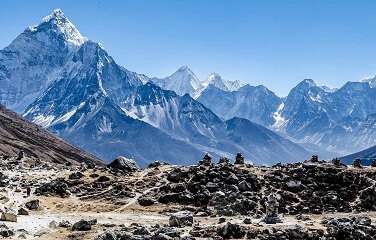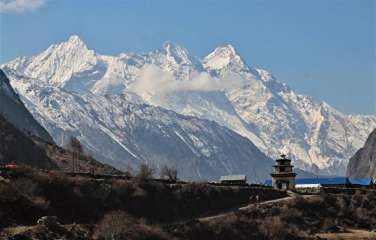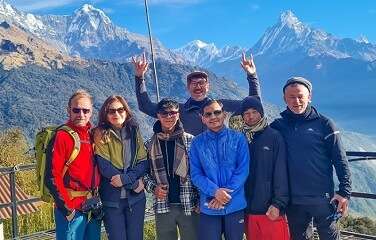Overview of the Langtang Gosaikunda Trek
.jpg)
The Langtang Gosaikunda Trek combines two iconic trails: the Langtang Valley trek and the Gosaikunda Lake trek. The journey spans approximately 12–15 days and takes trekkers through a diverse landscape ranging from lush green forests to rugged alpine terrain.
- Starting Point: Syabrubesi
- Ending Point: Sundarijal or Dhunche
- Max Elevation: 4,610 meters (15,120 feet) at Gosaikunda Pass
- Difficulty: Moderate to Challenging
- Best Time to Trek: March-May (Spring) and September–November (Autumn)
Highlights of the Trek
Cultural Encounters:
- The trek traverses through Tamang and Sherpa villages, offering insights into their traditional lifestyles, vibrant festivals, and rich heritage.
- Tamang Heritage: Experience warm hospitality, traditional dances, and Buddhist monasteries.
- Kyanjin Gompa: A spiritual and cultural highlight located in Langtang Valley.
Natural Beauty:
- The region boasts a variety of landscapes, from subtropical forests teeming with wildlife to dramatic glacial valleys and serene alpine lakes.
- Langtang Valley: Known as the “Valley of Glaciers,” it is home to breathtaking peaks like Langtang Lirung (7,227 meters).
- Gosaikunda Lakes: A series of sacred lakes surrounded by rugged peaks, revered by both Hindus and Buddhists.
Adventure and Solitude:
Compared to the more crowded Everest and Annapurna regions, the Langtang Gosaikunda trek offers a quieter, more intimate trekking experience.
Detailed Itinerary
.jpg)
Day 1: Kathmandu to Syabrubesi (1,503 m)
A scenic 7–8 hour drive through hills and terraced fields.
Day 2: Syabrubesi to Lama Hotel (2,470 m)
Trek through rhododendron and oak forests, crossing suspension bridges.
Day 3: Lama Hotel to Langtang Village (3,430 m)
A gradual ascent through forested trails with glimpses of Langtang Lirung.
Day 4: Langtang Village to Kyanjin Gompa (3,870 m)
Explore yak pastures and ancient monasteries while surrounded by stunning peaks.
Day 5: Acclimatization and Exploration in Kyanjin Gompa
Optional hikes to Kyanjin Ri (4,773 m) or Tserko Ri (4,984 m) for panoramic views.
Day 6: Kyanjin Gompa to Lama Hotel
Retrace your steps, descending back to the forested trail.
Day 7: Lama Hotel to Thulo Syabru (2,230 m)
A steep descent followed by a climb through Tamang villages.
Day 8: Thulo Syabru to Laurebina Yak (3,920 m)
It is a challenging uphill trek with expansive views of Ganesh Himal and Annapurna.
Day 9: Laurebina Yak to Gosaikunda (4,380 m)
Reach the sacred Gosaikunda Lakes, surrounded by spiritual and natural beauty.
Day 10: Gosaikunda to Ghopte (3,440 m)
Cross the challenging Laurebina Pass (4,610 m) before descending.
Day 11: Ghopte to Kutumsang (2,470 m)
Pass through serene forests and traditional villages.
Day 12: Kutumsang to Sundarijal (1,410 m) and Drive to Kathmandu
The final day involves trekking through Helambu villages and descending to Sundarijal, where a vehicle awaits to take you back to Kathmandu.
Key Attractions
Gosaikunda Lakes:
- These alpine lakes hold immense spiritual significance. Hindus believe that Lord Shiva created Gosaikunda by striking his trident into the ground to quench his thirst.
- The emerald-green waters are surrounded by snow-capped peaks, making it a photographer’s paradise.
Langtang Valley:
- Known for its unique topography, the valley is a mosaic of glacial streams, yak pastures, and Buddhist prayer flags fluttering against the mountains.
Wildlife and Flora:
- Langtang National Park is home to diverse wildlife, including red pandas, Himalayan tahr, and snow leopards. The forests are adorned with rhododendrons, making the trail vibrant in spring.
Why Langtang Gosaikunda is Nepal’s Hidden Gem
.jpg)
Authenticity:
The trek remains less commercialized, preserving its authenticity and offering a raw, immersive experience.
Accessibility:
Unlike the Everest and Annapurna regions, Langtang is just a day’s drive from Kathmandu, making it convenient for trekkers with limited time.
Diverse Experiences:
The combination of spiritual, cultural, and natural elements sets this trek apart.
Post-Earthquake Revival:
The Langtang region was severely affected by the 2015 earthquake. The resilience of the local communities adds an inspiring dimension to the trek.
Practical Tips for Trekkers
Permits:
- Langtang National Park Entry Permit
- TIMS (Trekkers’ Information Management System) Card
Physical Preparation:
- Moderate fitness is required, with some high-altitude sections demanding acclimatization.
Accommodation and Meals:
- Teahouses provide basic lodging and meals. Expect Dal Bhat, noodles, and soups as staples.
Packing Essentials:
- Warm layers, waterproof gear, sturdy trekking boots, and a first-aid kit.
Cultural and Spiritual Significance
.jpg)
The Langtang Gosaikunda Trek is not just a journey through stunning landscapes; it is also a pilgrimage of cultural and spiritual exploration.
Tamang and Sherpa Heritage:
The Tamang people are the predominant ethnic group in the Langtang region. With their Tibetan-influenced traditions, you’ll find intricately carved mani walls, prayer wheels, and stupas dotting the trail. The Sherpa communities contribute to the rich tapestry of local culture with their deep-rooted Buddhist beliefs.
Gosaikunda: The Sacred Lakes:
The Gosaikunda lakes are a vital spiritual site for both Hindus and Buddhists. Pilgrims from Nepal and India trek here during the Janai Purnima festival, a celebration marked by rituals and prayers at the lakes. The mythology of Lord Shiva and the lakes' creation adds a mystical allure to this high-altitude sanctuary.
Kyanjin Gompa:
This centuries-old monastery is a center of spiritual life in Langtang Valley. Visitors often spend time observing monks performing prayers or meditating in this serene environment.
Unique Aspects of the Langtang Gosaikunda Trek
Proximity to Kathmandu:
Despite its proximity to the bustling capital, the Langtang region feels like a world apart. The trek offers a remote wilderness experience without the logistical challenges of more distant regions.
Off-the-Beaten-Path:
Langtang Gosaikunda attracts fewer trekkers than Everest or Annapurna, ensuring tranquility and a closer connection with nature.
Trekking in a National Park:
The Langtang National Park is Nepal's first Himalayan national park, established in 1976. The park protects unique ecosystems, ensuring trekkers can experience pristine nature.
Ethical and Community-Centered Tourism:
Post-2015 earthquake, the Langtang region has embraced tourism as a path to recovery. Staying in locally run teahouses and purchasing handmade crafts contribute directly to the livelihoods of resilient local communities.
Flora and Fauna
.jpg)
Langtang National Park is a biodiversity hotspot, showcasing the unique ecology of the Himalayas.
Forests and Flowers:
The lower altitudes feature lush subtropical forests of oak, maple, and pine. As you ascend, rhododendron forests burst into vivid bloom during spring, creating vibrant trails.
Wildlife:
The park is home to elusive snow leopards, red pandas, Himalayan black bears, and langurs. Birdwatchers can spot colorful pheasants, Himalayan griffons, and rosefinches.
Alpine Terrain:
At higher altitudes, the forests give way to rocky terrain adorned with wildflowers, glacial streams, and moss-covered boulders.
Challenges and Rewards
Every great trek comes with its set of challenges, and the Langtang Gosaikunda trek is no exception.
Altitude:
The highest point, Laurebina Pass (4,610 m), can test trekkers with thinner air. Proper acclimatization is key to avoiding altitude sickness.
Steep Ascents and Descents:
Some sections, like the climb to Gosaikunda and the descent from the pass, require stamina and mental determination.
Remote Conditions:
While teahouses are available, the facilities are basic. Hot showers, Wi-Fi, and charging may not always be accessible.
Despite these challenges, the rewards are immense: breathtaking sunrises over snow-capped peaks, serene alpine lakes, and the deep satisfaction of completing a meaningful adventure.
Alternative Trekking Routes and Extensions
If time permits, trekkers can combine the Langtang Gosaikunda Trek with other nearby routes or add detours to enhance the experience.
Tamang Heritage Trail:
This extension explores more Tamang villages, offering an immersive cultural experience.
Helambu Circuit Trek:
The trek can be extended to include the Helambu region, known for its picturesque landscapes and rich Buddhist culture.
Ganja La Pass:
For experienced trekkers seeking an additional challenge, crossing the Ganja La Pass (5,106 m) offers an exhilarating adventure with stunning views.
Photography Tips
.jpg)
The Langtang Gosaikunda Trek offers endless opportunities for photographers:
Golden Hours:
Sunrise and sunset provide the best lighting for capturing the mountains and valleys in their full glory.
Wildlife:
A telephoto lens is essential for photographing elusive animals like red pandas or Himalayan tahrs.
Reflection Shots:
The Gosaikunda lakes provide perfect settings for capturing reflections of the surrounding peaks.
Sustainable Trekking Practices
Trekking in the Langtang Gosaikunda region comes with the responsibility of preserving its natural and cultural heritage.
Leave No Trace:
Carry all trash back to Kathmandu and avoid using single-use plastics.
Respect Local Culture:
Always ask for permission before taking photographs of people or their homes, and dress modestly in villages.
Support Local Businesses:
Choose locally run teahouses and purchase handmade crafts directly from villagers.
Personal Testimonials from Trekkers
Many trekkers who have completed the Langtang Gosaikunda Trek describe it as a life-changing experience. Here are a few reflections:
“The Langtang Valley is one of the most beautiful places I’ve ever visited. The warm hospitality of the Tamang people and the stunning views of Langtang Lirung are unforgettable.”
“Crossing the Laurebina Pass was challenging, but reaching the Gosaikunda lakes was a spiritual moment. It felt like stepping into another world.”
“The trek gave me a deeper appreciation for Nepal’s natural beauty and resilience. It’s a hidden gem that everyone should explore.”
Final Thoughts
The Langtang Gosaikunda Trek is truly Nepal’s hidden gem, offering an extraordinary blend of culture, nature, and adventure. Whether you’re drawn to the spiritual tranquility of Gosaikunda, the rugged beauty of Langtang Valley, or the warm hospitality of the Tamang people, this trek promises an unparalleled experience.
For trekkers seeking to escape the crowds and immerse themselves in an authentic Himalayan adventure, the Langtang Gosaikunda Trek is the perfect choice. It’s not just a trek—it’s a journey that leaves an indelible mark on the soul.

.jpg)



